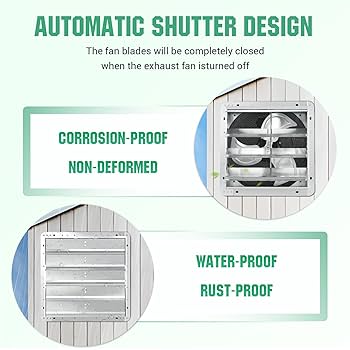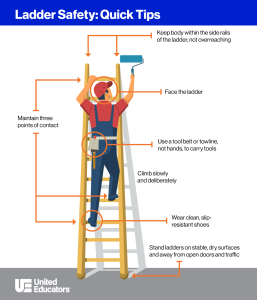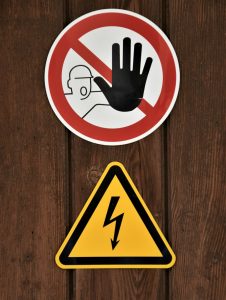If you spend time working in your garage, you know how important it is to keep the air fresh and safe. Poor ventilation can cause fumes, dust, and heat to build up, making your workspace uncomfortable and even dangerous.
But don’t worry—improving your garage workshop ventilation doesn’t have to be complicated or expensive. You’ll discover simple, effective ways to create a healthier environment for your projects. Keep reading to learn how to breathe easier and work smarter in your garage every day.
Importance Of Garage Ventilation
Proper ventilation in your garage workshop is not just a comfort issue—it’s a crucial factor for safety and efficiency. Without good airflow, your workspace can quickly become hazardous and less productive. Understanding why ventilation matters will help you create a healthier and more effective environment.
Health Risks Of Poor Airflow
Stale air in a garage workshop traps dust, fumes, and chemicals. Breathing in these pollutants can lead to headaches, dizziness, and long-term respiratory problems.
If you’ve ever worked in a poorly ventilated space, you might have noticed feeling tired or lightheaded. This is your body reacting to the harmful buildup of particles and gases.
Good ventilation reduces these risks by constantly exchanging indoor air with fresh outdoor air, keeping your lungs safe and your mind sharp.
Impact On Workshop Equipment
Moisture and dust accumulation harm your tools and machines. Rust can develop quickly on metal parts, and delicate electronics may malfunction.
Imagine your expensive power tools deteriorating faster just because of poor airflow. It’s frustrating and costly.
Ventilation helps control humidity and dust levels, extending the life of your equipment and saving you money on repairs or replacements.
Energy Efficiency Benefits
Ventilation can actually help regulate temperature without overusing heating or cooling systems. Proper airflow removes excess heat during summer and reduces dampness in winter.
This natural balance means your energy bills can stay lower while your workshop remains comfortable year-round.
Have you noticed how a well-ventilated space feels easier to work in without constantly adjusting the thermostat? That’s energy efficiency at work.

Credit: shop.vents-us.com
Types Of Ventilation Systems
Choosing the right ventilation system for your garage workshop can make a huge difference in comfort and safety. Different types of ventilation systems offer unique benefits depending on your space, budget, and work style. Understanding these options helps you create a healthier environment that keeps fumes and dust under control.
Natural Ventilation Options
Natural ventilation relies on airflow through windows, vents, and doors without using electricity. It’s the simplest and most cost-effective way to freshen your garage air. You might add adjustable vents or install a few windows that open to catch cross breezes.
Think about how you can position openings to maximize airflow. Have you noticed how opening a window on one side and a door on the opposite side lets air flow naturally? This creates a continuous exchange that removes stale air.
However, natural ventilation depends on weather and outdoor air quality. If you live in a dusty area or work with strong fumes, you might need more reliable airflow solutions.
Mechanical Ventilation Solutions
Mechanical systems use fans and ducts to control airflow actively. Exhaust fans pull out polluted air while intake fans bring in fresh air, making them very effective in workshops with strong fumes or limited openings.
You can install wall-mounted or ceiling fans designed specifically for garage use. Some models come with filters to trap dust or chemicals, improving air quality even more.
Have you considered how noise levels and energy use might affect your choice? A quiet, energy-efficient fan can keep your workspace comfortable without distraction.
Hybrid Ventilation Approaches
Hybrid systems combine natural and mechanical ventilation to balance efficiency and energy use. You might rely on natural airflow during mild weather and switch to fans when needed.
For example, installing vents that open automatically when fans run helps optimize airflow without wasting energy. This approach adapts to changing conditions and keeps your garage fresh year-round.
Does your workshop layout allow for flexible airflow control? Hybrid systems offer versatility that can match how you use your space throughout the year.
Choosing The Right Ventilation
Ventilating your garage workshop isn’t just about staying comfortable—it’s essential for safety and productivity. Poor ventilation can lead to overheating, lingering fumes, and even damage to equipment. Choosing the right ventilation system ensures you have a workspace that’s safe, efficient, and tailored to your needs.
Assessing Garage Size And Layout
The size and layout of your garage are critical factors when selecting ventilation. A small one-car garage may only need a basic exhaust fan, while a larger workshop could require multiple vents or a more advanced system like a powered attic fan.
Think about the placement of tools and workstations. If your workbench is in a corner, you’ll want airflow directed there to remove dust and fumes effectively. Map out your space and determine where ventilation is needed most.
Considering Climate And Weather
Your local climate plays a big role in ventilation choices. In warmer regions, you might need a system that includes cooling features like a ceiling fan or air exchanger. Cold climates, on the other hand, demand options that maintain warmth while removing stale air.
Weatherproofing is also important. If your area gets heavy rain or snow, ensure your ventilation system has seals or covers to prevent water from seeping in. Keep your workshop functional year-round by choosing the right system for your environment.
Budget And Installation Factors
How much are you willing to spend? Ventilation systems can range from under $100 for basic fans to thousands for high-tech air filtration units. Define your budget early to narrow down your options.
Don’t forget installation costs. Some systems are DIY-friendly, while others might require professional help. If you’re handy, you can save money by installing a fan or vent yourself, but larger systems may need expert guidance.
Balancing cost, efficiency, and ease of installation will help you make the right decision for your workshop.

Credit: www.duramaxshedsdirect.com
Installation Tips And Best Practices
Creating a well-ventilated garage workshop is essential for safety, comfort, and efficiency. Poor ventilation can lead to heat buildup, lingering fumes, and even potential health risks. Let’s dive into some actionable installation tips and best practices to ensure your garage workshop stays fresh and functional.
Placement Of Vents And Fans
Strategic placement of vents and fans makes all the difference in achieving good airflow. Position intake vents low on the walls to pull in fresh air and place exhaust vents higher to expel warm, stale air. This natural flow aligns with how hot air rises and keeps your space balanced.
Install fans near workstations that generate fumes, like near your welding area or painting station. Wall-mounted fans are a great option to save floor space while targeting specific zones. If possible, position exhaust fans opposite the intake vents to create a smooth cross-ventilation system.
Ensuring Proper Airflow Direction
Airflow direction is crucial to prevent fumes or dust from circulating back into your workspace. Test the airflow with a simple smoke test—light a stick of incense and observe the direction of the smoke. It should move smoothly toward the exhaust vent.
Make sure the airflow doesn’t blow directly at you while working with hazardous materials. Redirect it slightly to sweep fumes away without overwhelming your breathing zone. If you’re installing ducted systems, double-check that the ducts are sealed properly to avoid leaks or backflow.
Maintenance And Cleaning
Even the best ventilation systems need regular maintenance to keep working efficiently. Dust and debris can clog vents and fans, reducing airflow and creating a fire hazard. Clean the intake and exhaust vents at least once a month using a vacuum or a damp cloth.
For fans, remove the protective grill and wipe down the blades to avoid buildup. Don’t forget to check for loose screws or worn-out components while cleaning. Staying proactive with maintenance not only improves airflow but also extends the life of your ventilation system.
How often do you actually check your vents and fans? A little effort now can save you from costly repairs and an uncomfortable workspace down the line. Keep your workshop safe and efficient with these simple but effective practices.
Improving Air Quality Beyond Ventilation
Improving air quality in your garage workshop goes beyond just installing ventilation systems. While good airflow is essential, it’s equally important to manage the pollutants that ventilation alone can’t fully control. Taking extra steps can make your workspace safer, healthier, and more comfortable for long hours of work.
Using Air Purifiers
Air purifiers help remove tiny particles and harmful chemicals that ventilation might miss. Choose a purifier with a HEPA filter to catch dust, pollen, and even some fumes. Some models also include activated carbon filters to reduce odors and volatile organic compounds (VOCs).
If you spend a lot of time sanding, painting, or using adhesives, a purifier can drastically reduce the lingering dust and fumes. Position it near your workbench or where you do the most hazardous tasks. Do you notice how cleaner air improves your focus and reduces headaches?
Controlling Dust And Fumes
Dust and fumes are common in any workshop, but controlling them at the source makes a big difference. Use dust collection systems or shop vacuums directly connected to your tools. This prevents fine dust from spreading throughout the space.
For fumes, try to work with doors or windows open, even if you have ventilation fans. Use low-VOC or water-based products whenever possible to reduce harmful emissions. How often do you clean your filters and ducts? Neglecting this can cause buildup that worsens air quality.
Safe Storage Of Chemicals
Many garage workshops store paints, solvents, and other chemicals that release harmful vapors. Keep these items in tightly sealed containers and store them in a dedicated cabinet, ideally one that is ventilated or fire-resistant.
Label your containers clearly and avoid mixing chemicals in your workspace. This reduces accidental spills and dangerous reactions. Have you checked your storage areas recently for expired or unnecessary chemicals? Getting rid of them can improve air quality and safety.
Energy-saving Ventilation Strategies
Saving energy while keeping your garage workshop well-ventilated is not just smart—it’s essential. Efficient ventilation strategies can lower your utility bills and create a more comfortable workspace. Let’s look at practical ways to achieve this balance without sacrificing air quality or comfort.
Solar-powered Fans
Solar-powered fans use sunlight to run, meaning they cost you nothing to operate during the day. Installing these fans on your garage roof or near windows can push stale air out and pull fresh air in without drawing electricity from your grid.
Imagine your fan quietly working while you focus on your project, knowing it’s powered by free, renewable energy. These fans are especially useful if your workshop gets a lot of sun and you want a continuous airflow without extra costs.
Timed Ventilation Systems
Timed ventilation systems help you control when your fans or vents operate, reducing energy waste. You can program them to run only during peak workshop hours or when temperatures rise above a certain level.
This approach stops fans from running all day, which often happens when ventilation is manual. Have you ever forgotten to turn off a fan? Timed systems take that guesswork out and save energy by running only when needed.
Insulation And Sealing Tips
Proper insulation and sealing are key to keeping your workshop’s temperature stable, which reduces the need for constant ventilation. Seal gaps around windows, doors, and vents to prevent air leaks that force your fans or heaters to work harder.
Adding insulation to walls and ceilings keeps the space cooler in summer and warmer in winter. This means your ventilation system won’t need to run as often or as long, saving energy and creating a more pleasant workspace.

Credit: www.vevor.ca
Frequently Asked Questions
What Is The Importance Of Garage Workshop Ventilation?
Proper ventilation prevents harmful fumes, improves air quality, and enhances comfort during work. It ensures a safe and healthy workspace.
How Can I Improve Ventilation In My Garage Workshop?
Install exhaust fans, open windows, and use air purifiers. These methods enhance airflow and reduce pollutants effectively.
What Are Common Signs Of Poor Garage Ventilation?
Signs include stale air, excessive humidity, strong odors, and visible mold. Poor ventilation can lead to health risks and equipment damage.
Can Garage Workshop Ventilation Help Reduce Humidity?
Yes, proper ventilation reduces humidity by circulating air and preventing moisture buildup, protecting your tools and equipment from corrosion.
Conclusion
Good ventilation keeps your garage workshop safe and comfortable. It removes dust, fumes, and moisture that can harm your health. Fresh air helps tools last longer and work better. Simple steps like adding vents or fans make a big difference.
A well-ventilated space helps you focus and enjoy your projects more. Take time to plan your ventilation for a cleaner, safer workshop. Breathe easy and work smarter every day.








